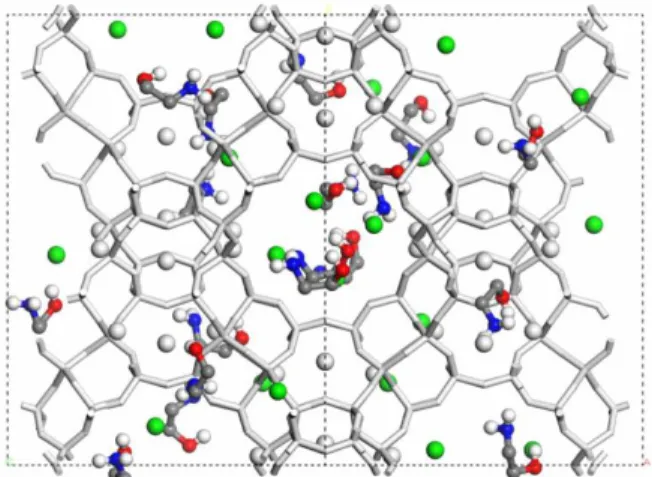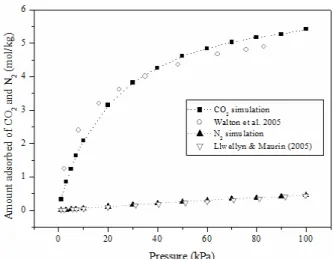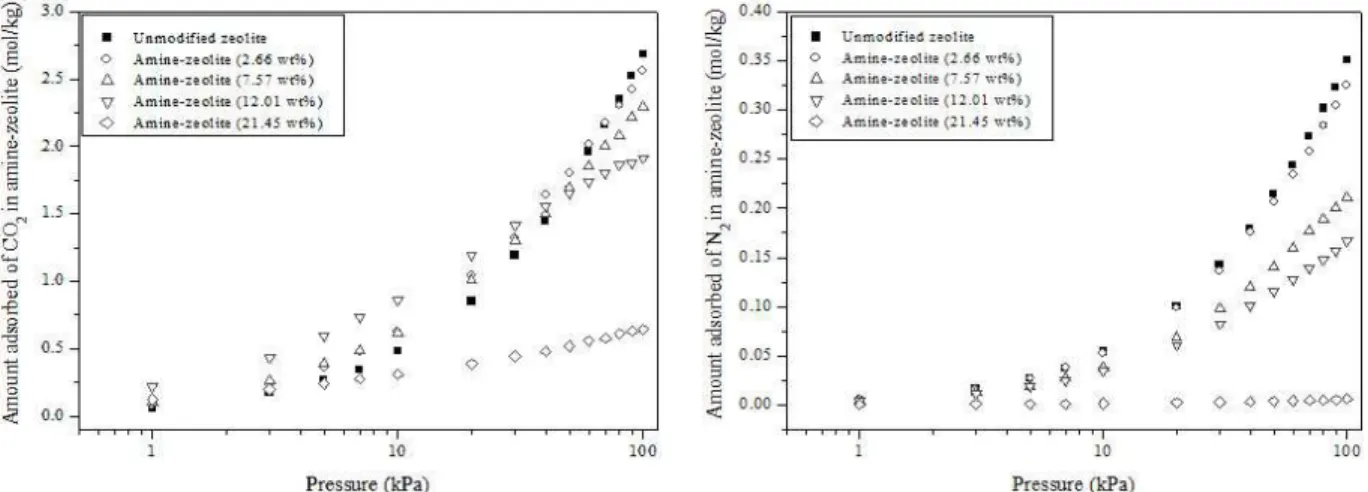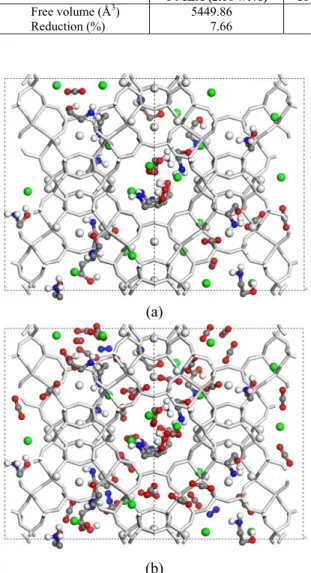ISSN 0104-6632 Printed in Brazil
www.abeq.org.br/bjche
Vol. 32, No. 03, pp. 663 - 669, July - September, 2015 dx.doi.org/10.1590/0104-6632.20150323s00003450
*To whom correspondence should be addressed
This is an extended version of the manuscript presented at the
VII Brazilian Congress of Applied Thermodynamics - CBTermo 2013, Uberlândia, Brazil.
Brazilian Journal
of Chemical
Engineering
THEORETICAL STUDY OF CO
2
:N
2
ADSORPTION
IN FAUJASITE IMPREGNATED WITH
MONOETHANOLAMINE
A. E. O. Lima
1, V. A. M. Gomes
1and S. M. P. Lucena
1*1Departamento de Engenharia Química, Grupo de Pesquisa em Separação por Adsorção (GPSA), Universidade
Federal do Ceará, Campus do Pici s/n Bl. 709, CEP: 60440-554, Fortaleza - CE, Brasil. Phone: + (55) (85) 3366 9611, Fax: + (55) (85) 3366 9601
E-mail: lucena@ufc.br
(Submitted: April 14, 2014 ; Revised: November 29, 2014 ; Accepted: December 5, 2014)
Abstract - Many efforts have been made to develop amine-based solid adsorbents for capture of CO2 by
adsorption. Compared with the traditional process of absorption in aqueous solutions of amines, the adsorbents with amine immobilized in solids generally result in processes with lower capital and energy costs. The literature contains some experimental studies of CO2 adsorption in impregnated materials; however, few
studies are devoted to the theoretical interpretation of this system in terms of CO2 capture for post-combustion
(N2 mixture with a low partial pressure of CO2). Therefore, this study investigates the adsorption of a CO2:N2
mixture on zeolite NaX impregnated with monoethanolamine (MEA), using molecular simulation. A model of NaX impregnated with MEA was proposed and the adsorption of a 15:85 (CO2:N2) mixture was investigated
based on the Monte Carlo method. The simulation of the MEA impregnated zeolite at 25 °C predicted higher CO2 selectivity and significant improvement in the heat of adsorption. Unfortunately, the adsorption heat
improvement did not translate into corresponding increases in the amount of adsorbed CO2. Moreover, MEA
concentrations higher than 12 wt% hindered the adsorption of CO2 molecules. An explanation for the results
in terms of occupied volumes and interaction energies is presented.
Keywords: Molecular simulation; CO2 adsorption; Faujasite; Monoethanolamine.
INTRODUCTION
Among the greenhouse gases, CO2 emission can contribute significantly to global warming. CO2 is currently the focus of several studies, where goals are directed towards enhancement of efficient proc-esses for their capture. CO2 absorption using amines is a mature technology and has proven efficient for CO2 capture (Rochelle, 2009), despite being limited by high cost and technical problems such as a high equipment corrosion rate (Knudsen et al., 2009). Thus, many capture processes have been studied; among these, adsorption is a very promising technology (Samantha et al., 2012). In a post-combustion
study is to perform a theoretical study of selective ad-sorption of CO2 on plain NaX sieve and NaX im-pregnated with monoethanolamine (MEA) in operat-ing conditions of pressure and concentrations similar to the post-combustion operation.
METHODOLOGY
Intermolecular Interactions
The interactions between the adsorbate molecules and the adsorbent (solid-fluid) and between mole-cules of adsorbate (fluid-fluid) were modeled with a Lennard-Jones 12-6 potential (LJ), which takes into account geometric (σij) and energy (εij) parameters.
The contributions of electrostatic interactions are also accounted for in the calculation of the total energy of the system (Uij), as shown in Equation (1).
12 6
4
⎡⎛ ⎞ ⎛ ⎞ ⎤ ⎛ ⎞
⎢ ⎥
= ⎜⎜ ⎟⎟ −⎜⎜ ⎟⎟ +⎜⎜ ⎟⎟
⎢⎝ ⎠ ⎝ ⎠ ⎥ ⎝ ⎠
⎣ ⎦
ij ij i j
ij ij
ij ij ij
q q U
r r r
σ σ
ε (1)
where rij is the distance between two interacting
spe-cies and q the partial charge of the atoms. The Lorenz-Berthelot simple mixing rules were used to calculate the interspecies parameters.
Faujasite
The NaX model was based on the crystallo-graphic data reported by Zhu and Seff (1999). NaX crystallizes in the cubic space group Fd3m with a cell size parameter of 25.077 Å. The zeolite frame-work was built avoiding Al-O-Al connections in ac-cordance with Lowenstein’s rule. The positioning of the compensating Na+ cations was randomly distrib-uted (32 in site I', 32 in site II and 28 in site III). Then, six cations were removed at random from site III to give a Si/Al ratio = 1.23. As done previously (Maurin et al., 2005; Watanabe et al., 1995; Garcia-Sanchez et al., 2009), the sodalite volume was blocked with large "dummy" atoms, preventing the adsorption in this region. The gas molecules adsorb only in the supercages that have a 12-ring window access with 7.4 Å of aperture. The sodalite unit can only be accessed by 6-rings windows of about 2.53 Å of diameter, which restricts the access of the gas molecules (Baerlocher et al. 2007). The NaX unit cell detailing cation positioning, supercage and so-dalite cages is shown in Figure 1.
The distribution of partial charges was obtained by the electronegativity equalization method (Rappe
and Goddard, 1991). The simulation parameters were extracted from the Universal Force Field (Rappe et al., 1992) and other parameters were adjusted em-pirically to best represent the experimental data. The parameters are shown in Table 1.
(a)
(b)
Figure 1: (a) NaX unit cell. (b) Hexagonal prism de-tailing supercage (S) and the sodalite cavity (sod). Atoms: Si - yellow, Al - pink, O- red. Cations colors: SI' and SII - Purple, SIII – Green. Big gray spheres - dummy atom.
Table 1: Force field parameters for the NaX zeolite.
Atom σss (Å) εss(kcal/mol) q (e)
Si 3.827a 0.092b (CO2) +1.208
0.170b (N2)
Al 4.008a 0.111b (CO2) +1.200
0.215b (N2)
O 3.118a 0.070b -0.765
Na (site I’, II) 2.658a 0.030a +0.768
Na (site III) 2.658a 0.030a +0.610
Brazilian Journal of Chemical Engineering Vol. 32, No. 03, pp. 663 - 669, July - September, 2015
Monoethanolamine
The model for MEA follows the molecular ge-ometry and charges proposed by Alejandre et al. (2000) with bond lengths and angles similar to ex-perimental spectroscopic measurements. The force field developed by Button et al. (1996) was used (Table 2) to compute LJ parameters. To reduce the time for equilibrium calculations, the central hydro-gen atoms were grouped together at the center of mass of the carbon atoms (CH2-CH2) as shown in Figure 2.
Table 2: MEA force field parameters.
Site σff (Å) εff(kcal/mol) q (e)
HN - - +0.347b
N 3.250a 0.169a -0.938b
CH2 3.905a 0.118a +0.257b
OMEA 3.070a 0.169a -0.644b
HO - - +0.374b
a - Button et al. (1996); b - Alejandre et al. (2000).
Figure 2: MEA molecule (H - white, N - blue, O - red, pseudo atom CH2 - gray).
Impregnation Model
The simulation cell of faujasite was impregnated with MEA at 0.05 kPa, and a temperature of 25 °C (conditions near the saturation pressure of MEA) so we could determine the zeolite maximum adsorption capacity of MEA. These calculations were per-formed in the grand canonical ensemble with the Monte Carlo method. Near saturation, NaX can ac-commodate a maximum of 60 molecules inside the pores. To obtain the other impregnation models, MEA molecules were randomly removed to match with impregnated values of the experimental studies that use different impregnation concentrations. During the adsorption of CO2 and N2, the MEA molecules are considered to be fixed in their equilibrium position. Our model is an attempt to get first insight into a viable MEA impregnation model. A unit cell of NaX
loaded with 18 molecules of MEA is shown in Figure 3.
Figure 3: Unit cell of an impregnation model of NaX with 18 molecules of MEA. Atoms: N - blue, H - white, CH2 - gray, O- red. Cation color: SI' and SII - white, SIII - green.
Gas Molecules (CO2 and N2)
Carbon dioxide was represented by the EPM2 atom-atom model proposed by Harris and Yung (1995) with bond distance (C-O) of 1.149 Å. For N2, we used the model proposed by Murth et al. (1980), where the bond length (N-N) is 1.094 Å and the quadrupole mo-ment was modeled by a three-point charge (q). In Figure 4, a representation of the gas adsorbate mole-cules can be seen, and in Table 3, the LJ parameters.
(a) (b) Figure 4: Molecular models of a) CO2 and b) N2. (O
- red; C - gray; N - blue; Dummy atom yellow).
Table 3: CO2 and N2 force field parameters.
Atom σff (Å) εff(kcal/mol) q (e) C 2.757a 0.055a +0.6512a
O 3.033a 0.159a -0.3256a
N 3.320b 0.072b -0.4050a
Dummy - - +0.8100a a – Harris e Yung (1995); b - Murth et al. (1980).
Simulation Details
moves (rotation, translation, creation and destruc-tion) an additional movement was implemented for mixtures. It was based on the change of identities be-tween CO2 and N2 molecules. The simulation output is the absolute adsorbed quantity, which we used to chart the isotherms. All simulations were performed at 25 °C, with 2x106 equilibrium and 2x106 produc-tion steps. The Ewald Sum method was used to calculate the electrostatic contributions. The Lennard-Jones cutoff distance was 12.5 Å without long range corrections. A low cut of 0.4 Å and precision of 0.001 kcal/mol was applied. As done previously (Watanabe
et al., 1995; Maurin et al., 2005; Pillai et al., 2012), one symmetric faujasite unit cell was used as the simu-lation cell with periodic boundary conditions in all directions.
RESULTS AND DISCUSSION
Force Field Validation
The validation of the force field for the system zeolite/gases was first performed by comparing the computed monocomponent adsorption isotherm for CO2 and N2 and the experimental data reported by Walton et al. (2005) and Maurin et al. (2005) on NaX crystals, respectively (Figure 5). The simulated nitrogen isotherm presented a better fit than carbon dioxide. However, our fit between CO2 experimental and simulated isotherms was improved if compared with other CO2 simulated data on NaX (Maurin et al., 2005; García-Sanchez et al., 2009). Some factors that contribute to inaccuracies between simulated and experimental isotherms are: 1- experimental uncer-tainty regarding the cation positioning (particularly site III') and 2- the fact that simulations were per-formed considering a perfect and periodic crystal structure, which differs from experimental samples, where crystal imperfections may interfere in the ad-sorption profile. As stated in other studies (Maurin et al., 2005) we also observed that, at low pressure, CO2 occupies the supercage near the cations on site III’. As the pressure increases, the cations located in site II are populated.
Other parameters for validation that can be used are: adsorption heat and CO2:N2 selectivity. Our simu-lated adsorption heat of -8.15 kcal/mol is consistent with the experimental data of 10 kcal/mol reported by Maurin et al. (2005). Our simulated CO2:N2 se-lectivity (Equation (2)) for an equimolecular mixture was -12.1 (100 kPa and 25 °C) versus -13.8 (101.3 kPa and 30 °C) obtained experimentally by Pillai et al. (2012).
Figure 5: Simulated and experimental monocompo-nent adsorption isotherms of CO2 and N2 on NaX. Simulated and CO2 experimental isotherms (Walton
et al., 2005) were performed at 25 °C. N2 experimental
isotherm (Maurin et al., 2005) was performed at 27 °C.
Impregnation Impact in Adsorption
As noted previously, we estimated that faujasite adsorbed a maximum of 60 molecules of MEA (21.45% wt). We then randomly deleted MEA mole-cules to obtain new impregnated models with 6, 18 and 30 immobilized molecules, representing a range of concentrations of 2.66, 7.57 and 12.01% by weight of the MEA inside the zeolite pores. This range of concentrations is found in experimental studies of impregnation (Jadhav et al., 2007; Silva et al., 2012). First we verified how MEA modified the heat of adsorption (Figure 6). NaX without impregnation pro-vides an average value of -8.15 kcal/mol and this value grows with the amount of amine impregnated, showing median values of 8.8 kcal/mol, 9.5 kcal/mol, 10.4 kcal/mol until reaching a maximum value of -12.4 kcal/mol for the models with 2.66, 7.57, 12.01 and 21:45 wt% MEA, respectively. This means that the presence of molecules of MEA effectively cre-ates stronger adsorption sites. However, the simu-lated 15:85 (CO2:N2) mixture isotherms in the im-pregnation models show that the increase in heat of adsorption did not translate into a corresponding in-crease of CO2 adsorption. This was particularly true for the models with a high loading of immobilized MEA (Figure 7).
Brazilian Journal of Chemical Engineering Vol. 32, No. 03, pp. 663 - 669, July - September, 2015
adsorption, showed a drastic decrease in its adsorp-tion capacity. No improvement was observed for N2. With the exception of the 2.55 wt% model, the N2 loading decreased for all impregnation models tested (Figure 7).
Our simulated results for the impregnated mate-rial (isotherms and adsorption heat) are similar to several experimental studies. For example, Silva et al. (2012) did CO2 microcalorimetric measurements on NaX impregnated with MEA and found a strong peak of adsorption heat at low coverage, but the ex-perimental isotherms with the impregnated material showed decreasing adsorption capacities with in-creasing concentration of MEA. Also, Jadhav et al. (2007) reported, via CO2 breakthrough curves,
de-creasing CO2 adsorption capacity in NaX with in-creased MEA impregnation.
The reason for the small enhancement of adsorp-tion capacity, despite the increase in the heat of ad-sorption, is related to the drastic reduction of the NaX micropore volume as the MEA molecules are introduced into the pores (Table 4). With 30 mole-cules of MEA (12.1 wt%) the useful volume of the faujasite is reduced by almost half (43.25%). The adsorption is completely impaired for the impregna-tion model with 60 MEA molecules (21.45 wt%) with the available volume reduced by 90.73%. A view of the CO2 and N2 population in the 18 MEA (7.57 wt%) model at 10 and 100 kPa is depicted in Figure 8.
Figure 6: Energy histograms of CO2 adsorption on zeolite NaX and in the impregnation models. Median values are: -8.15 kcal/mol, -8.8 kcal/mol, -9.5 kcal/mol, -10.4 kcal/mol and -12.4 kcal/mol for the models with 0, 2.66, 7.57, 12.01 and 21:45 wt% of MEA.
Table 4: Micropore volume decrease with impregnation. Theoretical volume calculated by the Connoly method (Connoly, 1983) using a spherical probe with 1.8 Å radius.
Model of immobilized faujasite Property
6 MEA (2.66 wt%) 18 MEA (7.57 wt%) 30 MEA (12.01 wt%) 60 MEA (21.45 wt%)
Free volume (Å3) 5449.86 4460.44 3349.04 546.87
Reduction (%) 7.66 24.42 43.25 90.73
(a)
(b)
Figure 8: Snapshots of the adsorption of the 15:85 (CO2:N2) mixture in the 18 MEA (5.75 wt%) impreg-nation model at 25 °C and 10 kPa (a) and 100 kPa (b). H-white, N-blue, O-red, pseudo atom CH2 and C-gray. Na+: SI' and SII - white, SIII – green.
Having foreseen satisfactory results for adsorp-tion only for the 18 MEA (7.57 wt%) impregnaadsorp-tion model, we turned to examine whether the introduc-tion of MEA could improve the selectivity. Based on the adsorbed values of the isotherms of Figure 7, we calculated CO2:N2 selectivity using Equation (2):
1 2
2 1 = X Y
S
X Y (2)
where Xi and Yi are the mole fractions of CO2 and N2
in the adsorbed (i=1) and gas phases (i=2), respec-tively. The selectivity calculations showed that the impregnated MEA causes an increase in selectivity (Table 5). The material without impregnation has selectivity of 44.2 that increases until a maximum value of 738.1 for the model with the higher degree of impregnation (60 MEA molecules).
Our results make it clear that there exists a trade-off between the creation of stronger sites with addi-tion of MEA molecules and the decrease of free pore volume for adsorption inside the NaX cavities. After inserted 18 MEA molecules, the effect of reduced volume available for adsorption of CO2 molecules prevails, decreasing substantially the amount adsorbed.
Table 5: Theoretical selectivity of CO2:N2 in NaX and impregnated models.
Simulated adsorption capacity
(mol/kg) at 25 °C and 50 kPa Adsorbent model
Carbon dioxide
Nitrogen
Selectivity (CO2:N2)
NaX (0 wt%) 1.677 0.215 44.2
6 MEA (2.66 wt%) 1.799 0.206 49.5 18 MEA (7.57 wt%) 1.696 0.141 68.3 30 MEA (12.01 wt%) 1.653 0.115 81.5 60 MEA (21.45 wt%) 0.521 0.004 738.1
CONCLUSIONS
Brazilian Journal of Chemical Engineering Vol. 32, No. 03, pp. 663 - 669, July - September, 2015
addition of molecules of MEA. It is also observed that the adsorbents impregnated with a high concen-tration of monoethanolamine exhibit significant loss of adsorption capacity due to the effect of free vol-ume reduction. The impregnation of NaX at concen-trations above 12 wt% of MEA, under the investi-gated conditions, is not recommended to increase the capture of CO2.
ACKNOWLEDGMENT
The authors wish to acknowledge the financial sup-port received from CNPq and CAPES.
REFERENCES
Alejandre, J., Rivera, J. L., Mora, M. A., Garza, V., Force field of monoethanolamine. Journal of Physi-cal Chemistry B, 104, 1332-1337 (2000).
Baerlocher, C., McCusker, L. B. and Olson, D. H., Atlas of Zeolites Framework Types. Sixth Revised Editon, Elsevier, Amsterdan (2007).
Button, J. K., Gubbins, K. E., Tanaka, H., Nakanishi, K., Molecular dynamics simulation of hydrogen bonding in monoethanolamine. Fluid Phase Equi-libria, 116, 320-325 (1996).
Cavenati, S., Grande, C. A., Rodrigues, A. E., Ad-sorption equilibrium of methane, carbon dioxide, and nitrogen on zeolite 13X at high pressures. Jour-nal of Chemical & Engineering Data, 49, 1095-1101 (2004).
Connolly, M. L., Solvent-accessible surfaces of pro-teins and nucleic acids. Science, 221, 709-13 (1983).
Garcıa-Sanchez, A., Ania, C. O., Parra, J. B., Dub-beldam, D., Vlugt, T. J. H., Krishna, R. and Calero, S., Transferable force field for carbon dioxide ad-sorption in zeolites. J. Phys. Chem. C, 113, 8814-8820 (2009).
Harris, J. G., Yung, K. H., Carbon dioxide's liquid-vapor coexistence curve and critical properties as predicted by a simple molecular model. Journal of Physical Chemistry, 99, 12021-12024 (1995). Jadhav, P. D., Chatti, R. V., Biniwale, R. B.,
Labhset-war, N. K., Devotta, S., Rayalu, S. S., Monoetha-nol amine modified zeolite 13X for CO2 adsorp-tion at different temperatures. Energy & Fuels, 21, 3555-3559 (2007).
Knudsen, J. N., Jensen, J. N., Vilhelmsen, P. J., Biede,
O., Experience with CO2 capture from coal flue gas in pilot-scale: Testing of different amine sol-vents. Energy Procedia, 1, 783-790 (2009). Maurin, G., Llewellyn, P. L. and Bell, R. G.,
Adsorp-tion mechanism of carbon dioxide in faujasites: Grand Canonical Monte Carlo simulations and microcalorimetry measurements. Journal of Physi-cal Chemistry, B, 109, 16084-16091 (2005). Murth, C. S., Singer, K., Klein, M. L., McDonald, I.
R., Pairwise additive effective potentials for nitro-gen. Molecular Physics, 41, 1387-1399 (1980). Pillai, R. S., Peter, S. A., Jasra, R. V., CO2 and N2
ad-sorption in alkali metal ion exchanged X-Fau-jasite: Grand canonical Monte Carlo simulation and equilibrium studies. Micropor. Mesopor. Mat., 162, 143-151 (2012).
Rappe, A. K., Casewit, C. J., Colwell, K. S., God-dard, W. A., Skiff, W. M., UFF, A Full Periodic-Table Force-Field for Molecular Mechanics and Molecular – Dynamics Simulations. Journal of the American Chemical Society, 114, 10024-10035 (1992).
Rappe, A. K., Goddard, W. A. Charge equilibration for molecular dynamics simulations. J. Phys. Chem., 95, 3358-3363 (1991).
Rochelle, G. T., Amine scrubbing for CO2 capture. Science, 325, 1652-1654 (2009).
Samantha, A., Zhao, A., Shimizu, G. K. H., Sarkar, P., Gupta, R., Post-combustion CO2 capture using solid sorbents: A review. Industrial & Engineering Chemistry Research, 51, 1438-1463 (2012). Sayari, A., Belmabkhout, Y., Serna-Guerrero, R., Flue
gas treatment via CO2 adsorption. Chem. Eng. J., 171, 760-774 (2011).
Silva, F. W. M., Soares-Maia, D. A., Oliveira, R. S., Moreno-Pirajan, J. C., Sapag, K., Cavalcante Jr., C. L., Zgrablich, G., Azevedo, D. C. S., Adsorption microcalorimetry applied to the characterisation of adsorbents for CO2 capture. The Canadian Jour-nal of Chemical Engineering, 90, 1372-1380 (2012). Walton, K. S., Abney, M. B. and LeVan, M. D., CO2
adsorption in Y and X zeolites modified by alkali metal cation exchange. Micropor. Mesopor. Mat., 91, 78-84 (2006).
Watanabe, K., Austin, N. and Stapleton, M. R., In-vestigation of the air separation properties of zeo-lites types A, X and Y by Monte Carlo simula-tions. Molecular Simulation, 15, 197-221 (1995). Zhu, L., Seff, K., Reinvestigation of the crystal



